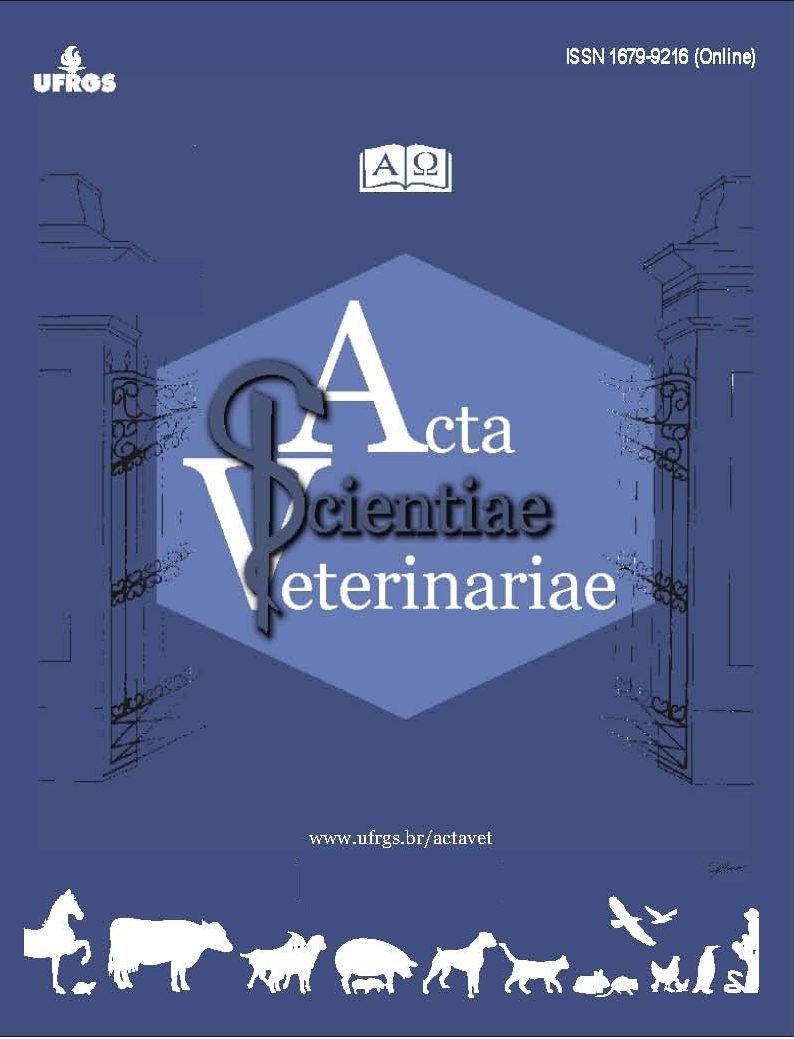Diagnóstico Ultrassonográfico de Ruptura do Tendão Gastrocnêmio em Cão
DOI:
https://doi.org/10.22456/1679-9216.140015Palavras-chave:
Achilles tendon, Gastrocnemius, Tendon rupture, Musculoskeletal ultrasoundResumo
Background: The gastrocnemius tendon, one of the components of the common calcaneal tendon (CCT), is integral in tarsal extension and knee flexion movement. CCT ruptures are uncommon, and ultrasound findings unique to the gastrocnemius component have been scarcely documented. This report aims to describe the ultrasonographic findings of a gastrocnemius tendon rupture in a dog— a topic not extensively covered in the literature, emphasizing the importance of ultrasound in diagnosing such ruptures.
Case: A four-year-old female greyhound weighing 20 kg was brought to a university veterinary hospital for a clinical evaluation due to acute lameness in the left hind limb. During the orthopedic examination, a suspected CCT rupture prompted an ultrasound examination. The left hind limb showed intact common and superficial digital flexor tendons, a heterogenous and substantially hypoechoic appearance of the gastrocnemius tendon, and an adjacent hematoma. These findings were consistent with a partial CCT rupture involving the gastrocnemius component. The suspicion was confirmed through gastrocnemius tenorrhaphy and temporary tarsal arthrodesis. The patient demonstrated limb function recovery post-surgery.
Discussion: Partial ruptures of CCT only involving the gastrocnemius component have been poorly described in the veterinary literature. While radiography is the preferred method of examination to diagnose suspected orthopedic conditions, ultrasound is widely available in small animal care and highly accurate in detecting such tendon injuries. This report elucidates the ultrasonographic characteristics of a complete gastrocnemius tendon rupture, underscoring the important role of ultrasound in the diagnosis as it effectively differentiates between complete and partial tendon ruptures and acute and chronic tendinopathies. More importantly, its sensitivity in determining the lesion location and extent proves invaluable when clinical and orthopedic examinations are inconclusive. Hence, its utility as an auxiliary tool for evaluating tendon injuries is emphasized.
Downloads
Referências
Abako J., Holak P., Głodek J. & Zhalniarovich Y. 2021. Usefulness of Imaging Techniques in the Diagnosis of Selected Injuries and Lesions of the Canine Tarsus. A Review. Animals. 11(6): 1834. DOI: 10.3390/ani11061834. DOI: https://doi.org/10.3390/ani11061834
Allawi A.H., Alkattan L.M. & Al Iraqi O.M. 2019. Clinical and ultrasonographic study of using autogenous venous graft and platelet-rich plasma for repairing Achilles tendon rupture in dogs. Iraqi Journal of Veterinary Sciences. 33(2): 453-460. DOI: 10.33899/IJVS.2019.163199. DOI: https://doi.org/10.33899/ijvs.2019.163199
Baltzer W.I. 2012. Sporting dog injuries. Veterinary Medicine. 4: 166-177.
Cook C.R. 2016. Ultrasound Imaging of the Musculoskeletal System. Veterinary Clinics of North America: Small Animal Practice. 46(3): 355-371. DOI: 10.1016/j.cvsm.2015.12.001. DOI: https://doi.org/10.1016/j.cvsm.2015.12.001
Fahie M.A. 2005. Healing, Diagnosis, Repair, and Rehabilitation of Tendon Conditions. Veterinary Clinics of North America: Small Animal Practice. 35(5): 1195-1211. DOI: 10.1016/j.cvsm.2005.05.008. DOI: https://doi.org/10.1016/j.cvsm.2005.05.008
Gamble L.J., Canapp D.A. & Canapp S.O. 2017. Evaluation of Achilles Tendon Injuries with Findings from Diagnostic Musculoskeletal Ultrasound in Canines – 43 Cases. Veterinary Evidence. 2(3). DOI: 10.18849/ve.v2i3.92. DOI: https://doi.org/10.18849/ve.v2i3.92
Hanna A., Owen T. & Mattoon J.S. 2021. Musculoskeletal system. In: Mattoon J.S., Sellon R.K. & Berry C.R. (Eds). Small Animal Diagnostic Ultrasound. 4th edn. Saint Louis: Elsevier, pp.544-565. DOI: https://doi.org/10.1016/B978-0-323-53337-9.00023-X
Henderson R.E., Walker B.F. & Young K.J. 2015. The accuracy of diagnostic ultrasound imaging for musculoskeletal soft tissue pathology of the extremities: a comprehensive review of the literature. Chiropractic and Manual Therapies. 23: 31. DOI: 10.1186/s12998-015-0076-5. DOI: https://doi.org/10.1186/s12998-015-0076-5
Henry G.A. 2014. Consolidação de Fraturas. In: Thrall D.E. (Ed). Diagnóstico de Radiologia Veterinária. 6.ed. Rio de Janeiro: Elsevier, pp.620-667.
Linn K. & Duerr F.M. 2020. Pelvic Limb Lameness: Tarsal Region. In: Duerr F.M. (Ed). Canine Lameness. Hoboken: Wiley-Blackwell, pp.281-306. DOI: https://doi.org/10.1002/9781119473992.ch18
Schulz K.S., Ash K.J. & Coock J.L. 2019. Clinical outcomes after common calcanean tendon rupture repair in dogs with a loop‐suture tenorrhaphy technique and autogenous leukoreduced platelet‐rich plasma. Veterinary Surgery. 48(7): 1262-1270. DOI: 10.1111/vsu.13208. DOI: https://doi.org/10.1111/vsu.13208
Singh B. 2018. The Locomotor Apparatus. In: Singh B. (Ed). Dyce, Sack and Wensing’s Textbook of Veterinary Anatomy. 5th edn. Saint Louis: Elsevier, pp.70-158.
Spinella G., Tamburro R., Loprete G., Vilar J.M. & Valentini S. 2010. Surgical repair of Achilles tendon rupture in dogs: a review of the literature, a case report and new perspectives. Veterinarni Medicina. 55(7): 303-310. DOI: 10.17221/2926-VETMED. DOI: https://doi.org/10.17221/2926-VETMED
Arquivos adicionais
Publicado
Como Citar
Edição
Seção
Licença
Copyright (c) 2024 Anna Vitória Hörbe, Catherine Konrad Nava Calva, Raquel Baumhardt, Fabiano da Silva Flores, Ingrid Rios Lima Machado, Felipe Auatt Batista de Sousa, Ricardo Pozzobon

Este trabalho está licenciado sob uma licença Creative Commons Attribution 4.0 International License.
This journal provides open access to all of its content on the principle that making research freely available to the public supports a greater global exchange of knowledge. Such access is associated with increased readership and increased citation of an author's work. For more information on this approach, see the Public Knowledge Project and Directory of Open Access Journals.
We define open access journals as journals that use a funding model that does not charge readers or their institutions for access. From the BOAI definition of "open access" we take the right of users to "read, download, copy, distribute, print, search, or link to the full texts of these articles" as mandatory for a journal to be included in the directory.
La Red y Portal Iberoamericano de Revistas Científicas de Veterinaria de Libre Acceso reúne a las principales publicaciones científicas editadas en España, Portugal, Latino América y otros países del ámbito latino





